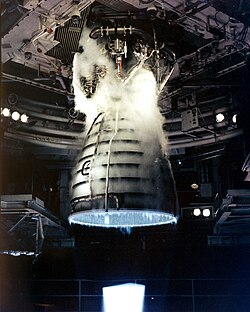
Back آر إس 25 Arabic মহাকাশ যানের মুখ্য ইঞ্জিন Bengali/Bangla RS-25 Catalan Space Shuttle Main Engine Czech Aerojet Rocketdyne RS-25 German Motores principales (transbordador espacial) Spanish موتور اصلی شاتل فضایی FA RS-25 Finnish Space Shuttle Main Engine French SSME GL
 RS-25 test firing. The bright area at the bottom of the picture is a Shock diamond | |
| Country of origin | United States |
|---|---|
| First flight | April 12, 1981 (STS-1) |
| Designer | Rocketdyne |
| Manufacturer |
|
| Associated LV | |
| Predecessor | HG-3 |
| Status | In use |
| Liquid-fuel engine | |
| Propellant | LOX / LH2 |
| Mixture ratio | 6.03:1 |
| Cycle | Fuel-rich dual-shaft staged combustion |
| Configuration | |
| Nozzle ratio | 78:1[1] |
| Performance | |
| Thrust, vacuum | 2,279 kN (512,300 lbf)[1] |
| Thrust, sea-level | 1,860 kN (418,000 lbf)[1] |
| Throttle range | 67–109% |
| Thrust-to-weight ratio | 73.1[2] |
| Chamber pressure | 2,994 psi (20.64 MPa)[1] |
| Specific impulse, vacuum | 452.3 s (4.436 km/s)[1] |
| Specific impulse, sea-level | 366 s (3.59 km/s)[1] |
| Mass flow | 514.49 kg/s (1,134.26 lb/s) |
| Dimensions | |
| Length | 4.3 m (168 in) |
| Diameter | 2.4 m (96 in) |
| Dry mass | 3,177 kg (7,004 lb)[2] |
| References | |
| References | [3][2] |
| Notes | Data is for RS-25D at 109% of rated power level. |
The RS-25, also known as the Space Shuttle Main Engine (SSME),[1] is a liquid-fuel cryogenic rocket engine that was used on NASA's Space Shuttle and is used on the Space Launch System.
Designed and manufactured in the United States by Rocketdyne (later Pratt & Whitney Rocketdyne and Aerojet Rocketdyne), the RS-25 burns cryogenic (very low temperature) liquid hydrogen and liquid oxygen propellants, with each engine producing 1,859 kN (418,000 lbf) thrust at liftoff. Although RS-25 heritage traces back to the 1960s, its concerted development began in the 1970s with the first flight, STS-1, on April 12, 1981. The RS-25 has undergone upgrades over its operational history to improve the engine's thrust, reliability, safety, and maintenance load.
The engine produces a specific impulse (Isp) of 452 seconds (4.43 kN-sec/kg) in vacuum, or 366 seconds (3.59 kN-sec/kg) at sea level, has a mass of approximately 3.5 tonnes (7,700 pounds), and is capable of throttling between 67% and 109% of its rated power level in one-percent increments. Components of the RS-25 operate at temperatures ranging from −253 to 3,300 °C (−400 to 6,000 °F).[1]
The Space Shuttle used a cluster of three RS-25 engines mounted at the stern of the orbiter, with fuel drawn from the external tank. The engines were used for propulsion throughout the spacecraft ascent, with total thrust increased by two solid rocket boosters and the orbiter's two AJ10 orbital maneuvering system engines. Following each flight, the RS-25 engines were removed from the orbiter, inspected, refurbished, and then reused on another mission.
Four RS-25 engines are installed on each Space Launch System, housed in the engine section at the base of the core stage, and expended after use. The first four Space Launch System flights use modernized and refurbished engines built for the Space Shuttle program. Subsequent flights will make use of a simplified RS-25E engine called the Production Restart, which is under testing and development.
- ^ a b c d e f g h "RS-25 Engine". Aerojet Rocketdyne. Archived from the original on July 3, 2014.
- ^ a b c Wade, Mark. "SSME". Encyclopedia Astronautica. Archived from the original on December 28, 2016. Retrieved December 28, 2017.
- ^ "Space Shuttle Main Engine" (PDF). Pratt & Whitney Rocketdyne. 2005. Archived from the original (PDF) on February 8, 2012. Retrieved November 23, 2011.